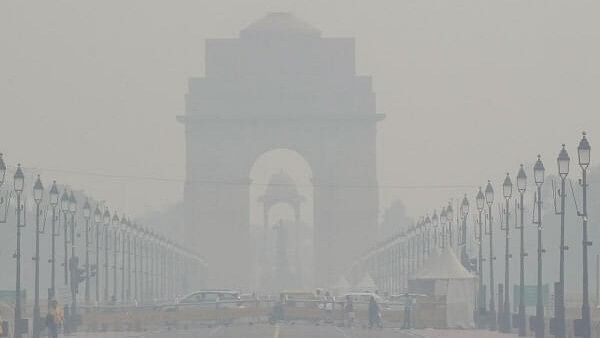
A thick layer of smog engulfs the India Gate in New Delhi.
Credit: PTI Photo
The CAQM, the Commission for Air Quality Management in National Capital Region and Adjoining Areas, constituted in 2021for better coordination, identification and resolution of air quality index in New Delhi, has been repeatedly admonished by the Supreme Court of India for its failure to curb air pollution and control stubble burning around the city. "You must implement your own orders. Everything is in the air. You are showing action plans and (outcome) of sectoral meetings, but there is no implementation of your orders," it said.
Effective and strict implementation is the Achilles heel in India’s battle against air pollution, and the pollution control boards are its weakest link, I wrote here last year—sadly, precious little has changed since then. The SC bench of Justice Abhay S Oka and Justice Augustine George Masih pointed out the “lack of adequate staff on the state pollution control boards and wondered how the agencies would tackle pollution and stubble burning during the onset of winter.” Ironically, the advocate representing the Haryana government pointed out that no data on stubble burning is available this year as the pollution control board officers were assigned to election duties.
Every September, the Delhi government launches a comprehensive action plan to tackle air pollution. Last year’s 14-point plan has been expanded to a broader 21-point strategy this year, which includes more and more useless measures like drone monitoring, road-sweeping, water sprinkling, and artificial rain. The ridiculous smog tower makes a comeback.
Every October, as soon as the monsoon season retreats, the denizens of Delhi wake up to their usual filthy air, grey skies, and congested lungs, and start looking for scapegoats. Multiple studies over the years have inventoried the pollution sources, from vehicular emissions and coal plants, to construction dust, burning of waste, and biomass for cooking and heating.
However, at the beginning of the air pollution season in Delhi, the blame is usually placed on stubble burning of wheat and paddy crops by the farmers of Uttar Pradesh, Punjab, and Haryana, as they prepare their fields to sow their first summer crop. This year the Supreme Court bench was the first one to pull up the state governments of Punjab and Haryana for collecting just nominal compensation from farmers burning paddy stubble while criticising the CAQM for not launching a single prosecution against cases registered over stubble burning.
It is difficult to imagine any government penalising farmers during election season, especially the poorer farmers who cannot afford the costly and time-consuming technology to convert straw into pellets, and yet the court has stressed the need to set aside political compulsions and said no change would occur if penal action was not being taken at the grassroots level.
Penal action at the grassroot level has failed in India. Remember, in 2022, India brought into effect the Plastic Waste Management Amendment Rules (2021) that banned 19 categories of ‘single-use plastics’(SUP). Yet, thanks to lax supervision and a reluctance by small businesses to embrace non-plastic alternatives the law has become toothless in a country that generates about 5.5 million tonnes of SUP waste annually, according to a report by the New Delhi-based non-profit Centre for Science and Environment (CSE).
Rebuked by the Supreme Court, flying squads may take off this week and find a few law-breaking farmers, fine them or even jail them, but without a sustained implementation strategy and economically feasible alternatives, the ban on stubble burning will be as ineffective as the plastic ban.
For instance, if Punjab farmers don't have money to pay for machines as argued by the lawyer representing the Punjab government, then the Centre and Delhi government must pay for crop management machines, and if the lawyer from Haryana tells the court that the pollution board employees were away on election duty, then the Supreme Court must take penal action against the officers of pollution control board.
Finally, New Delhi will never be able to solve its air pollution problem with its current myopic view, it needs to look beyond the NCR and adjoining areas to understand its air pollution crisis, after all 30% of Punjab’s pollution originates in Pakistan, like 30% of Bangladesh’s polluted air is blown in from India. Maybe it is now time to revive the Malé Declaration on Control and Prevention of Air Pollution and its likely transboundary effects for South Asia, a ministry-level regional agreement that includes India and Pakistan.
But wait, Diwali is around the corner, and the Delhi government is yet to notify the ban on firecrackers that it announced earlier last month, as it waits for the Lieutenant Governor of Delhi to approve it.
Shailendra Yashwant is a senior adviser to Climate Action Network South Asia (CANSA).
(Disclaimer: The views expressed above are the author's own. They do not necessarily reflect the views of DH).